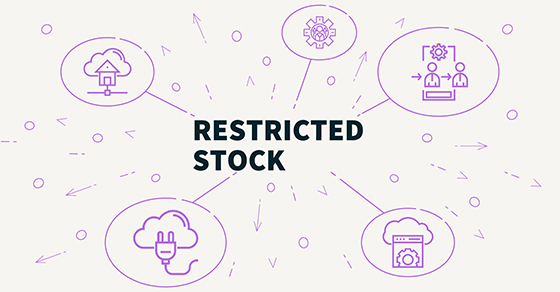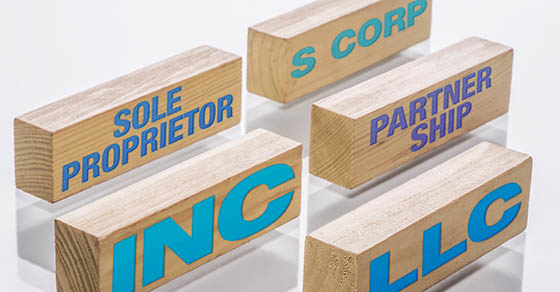Weekly Tax Brief
What you need to know about restricted stock awards and taxes
- Details
- Published: 09 November 2023 09 November 2023

Choosing a business entity: Which way to go?
- Details
- Published: 07 November 2023 07 November 2023

If you’re planning to start a business or thinking about changing your business entity, you need to determine what will work best for you. Should you operate as a C corporation or a pass-through entity such as a sole-proprietorship, partnership, limited liability company (LLC) or S corporation? There are many issues to consider.
Currently, the corporate federal income tax is imposed at a flat 21% rate, while individual federal income tax rates currently begin at 10% and go up to 37%. The difference in rates can be alleviated by the qualified business income (QBI) deduction that’s available to eligible pass-through entity owners that are individuals, and some estates and trusts.
Individual rate caveats: The QBI deduction is scheduled to end in 2026, unless Congress acts to extend it, while the 21% corporate rate is not scheduled to expire. Also, noncorporate taxpayers with modified adjusted gross incomes above certain levels are subject to an additional 3.8% tax on net investment income.
Organizing a business as a C corporation instead of a pass-through entity may reduce the current federal income tax on the business’s income. The corporation can still pay reasonable compensation to the shareholders and pay interest on loans from the shareholders. That income will be taxed at higher individual rates, but the overall rate on the corporation’s income can be lower than if the business was operated as a pass-through entity.
More to take into account
There are other tax-related factors to take into consideration. For example:
- If most of the business profits will be distributed to the owners, it may be preferable to operate the business as a pass-through entity rather than a C corporation, since the shareholders will be taxed on dividend distributions from the corporation (double taxation). In contrast, owners of a pass-through entity will only be taxed once, at the personal level, on business income. However, the impact of double taxation must be evaluated based on projected income levels for both the business and its owners.
- If the value of the assets is likely to appreciate, it’s generally preferable to conduct business as a pass-through entity to avoid a corporate tax when the assets are sold or the business is liquidated. Although corporate level tax will be avoided if the corporation’s shares, rather than its assets, are sold, the buyer may insist on a lower price because the tax basis of appreciated business assets cannot be stepped up to reflect the purchase price. That can result in much lower post-purchase depreciation and amortization deductions for the buyer.
- If the business is a pass-through entity, an owner’s basis in his or her interest in the entity is stepped-up by the entity income that’s allocated to the owner. That can result in less taxable gain for the owner when his or her interests in the entity are sold.
- If the business is expected to incur tax losses for a while, you may want to structure it as a pass-through entity so you can deduct the losses against other income. Conversely, if you have insufficient other income or the losses aren’t usable (for example, because they’re limited by the passive loss rules), it may be preferable for the business to be a C corporation, since it’ll be able to offset future income with the losses.
- If the owner of a business is subject to the alternative minimum tax (AMT), it may be preferable to organize as a C corporation, since corporations aren’t subject to the AMT. Affected individuals are subject to the AMT at 26% or 28% rates.
As you can see, there are many factors involved in operating a business as a certain type of entity. This only covers a few of them. For more details about how to proceed in your situation, consult with us.
© 2023
Contributing to your employer’s 401(k) plan: How it works
- Details
- Published: 02 November 2023 02 November 2023

If you’re fortunate to have an employer that offers a 401(k) plan, and you don’t contribute to it, you may wonder if you should participate. In general, it’s a great tax and retirement saving deal! These plans help an employee accumulate a retirement nest egg on a tax-advantaged basis. If you’re thinking about contributing to a plan at work, here are some of the advantages.
With a 401(k) plan, you can opt to set aside a certain amount of your wages in a qualified retirement plan. By electing to set cash aside in a 401(k) plan, you’ll reduce your gross income and defer tax on the amount until the cash (adjusted by earnings) is distributed to you in the future. It will either be distributed from the plan or from an IRA or other plan that you roll your proceeds into after leaving your job.
Tax benefits
Your wages or other compensation will be reduced by the pre-tax contributions that you make, which will save you current income taxes. But the amounts will still be subject to Social Security and Medicare taxes. If your employer’s plan allows, you may instead make all, or some, contributions on an after-tax basis. These are Roth 401(k) contributions. With Roth 401(k) contributions, the amounts will be subject to current income taxation, but if you leave these funds in the plan for a required time, distributions (including earnings) will be tax-free.
Your elective contributions — either pre-tax or after-tax — are subject to annual IRS limits. In 2023, the maximum amount permitted is $22,500. When you reach age 50, if your employer’s plan allows, you can make additional “catch-up” contributions. In 2023, that additional amount is up to $7,500. So if you’re 50 or older, the total that you can contribute to all 401(k) plans in 2023 is $30,000. Total employer contributions, including your elective deferrals (but not catch-up contributions), can’t exceed 100% of compensation or, for 2023, $66,000, whichever is less.
In a typical plan, you’re permitted to invest the amount of your contributions (and any employer matching or other contributions) among available investment options that your employer has selected. Periodically review your plan investment performance to determine that each investment remains appropriate for your retirement planning goals and your risk specifications.
Taking withdrawals
Another important characteristic of these plans is the limitation on withdrawals while you’re working. Amounts in the plan attributable to elective contributions aren’t available to you before one of the following events:
- Retirement (or other separation from service),
- Reaching age 59½,
- Disability,
- Plan termination, or
- Hardship.
Eligibility rules for a hardship withdrawal are strict. A hardship distribution must be necessary to help deal with an immediate and heavy financial need.
As an alternative to taking a hardship or other plan withdrawal while employed, your employer’s plan may allow you to receive a loan, which you pay back to your account with interest.
Matching contributions
Employers may opt to match 401(k) contributions up to a certain amount. Although matching is not required, surveys show that most employers offer some type of match. If your employer matches contributions, you should make sure to contribute enough to receive the full amount. Otherwise, you’ll lose out on free money!
These are just the basics of 401(k) plans for employees. For more information, contact your employer. Of course, we can answer any tax questions you may have.
© 2023
New per diem business travel rates kicked in on October 1
- Details
- Published: 31 October 2023 31 October 2023

Are employees at your business traveling and frustrated about documenting expenses? Or perhaps you’re annoyed at the time and energy that goes into reviewing business travel expenses. There may be a way to simplify the reimbursement of these expenses. In Notice 2023-68, the IRS announced the fiscal 2024 special “per diem” rates that became effective October 1, 2023. Taxpayers can use these rates to substantiate the amount of expenses for lodging, meals and incidentals when traveling away from home. (Taxpayers in the transportation industry can use a special transportation industry rate.)
Basics of the method
A simplified alternative to tracking actual business travel expenses is to use the “high-low” per diem method. This method provides fixed travel per diems. The amounts, provided by the IRS, vary from locality to locality.
Under the high-low method, the IRS establishes an annual flat rate for certain areas with higher costs of living. All locations within the continental United States that aren’t listed as “high-cost” are automatically considered “low-cost.” The high-low method may be used in lieu of the specific per diem rates for business destinations. Examples of high-cost areas include Boston, and San Francisco. Other locations, such as resort areas, are considered high-cost during only part of the year.
Under some circumstances — for example, if an employer provides lodging or pays the hotel directly — employees may receive a per diem reimbursement only for their meals and incidental expenses. There’s also a $5 incidental-expenses-only rate for employees who don’t pay or incur meal expenses for a calendar day (or partial day) of travel.
Reduced recordkeeping
If your company uses per diem rates, employees don’t have to meet the usual recordkeeping rules required by the IRS. Receipts of expenses generally aren’t required under the per diem method. But employees still must substantiate the time, place and business purpose of the travel. Per diem reimbursements generally aren’t subject to income or payroll tax withholding or reported on an employee’s Form W-2.
The FY2024 rates
For travel after September 30, 2023, the per diem rate for all high-cost areas within the continental United States is $309. This consists of $235 for lodging and $74 for meals and incidental expenses. For all other areas within the continental United States, the per diem rate is $214 for travel after September 30, 2023 ($150 for lodging and $64 for meals and incidental expenses). Compared to the FY2023 per diems, the high-cost area per diem increased $12, and the low-cost area per diem increased $10.
Important: This method is subject to various rules and restrictions. For example, companies that use the high-low method for an employee must continue using it for all reimbursement of business travel expenses within the continental United States during the calendar year. However, the company may use any permissible method to reimburse that employee for any travel outside the continental United States.
For travel during the last three months of a calendar year, employers must continue to use the same method (per diem or high-low method) for an employee as they used during the first nine months of the calendar year. Also, note that per diem rates can’t be paid to individuals who own 10% or more of the business.
If your employees are traveling, it may be a good time to review the rates and consider switching to the high-low method. It can reduce the time and frustration associated with traditional travel reimbursement. Contact us for more information or read the IRS notice here.
© 2023
Facing a future emergency? Two new tax provisions may soon provide relief
- Details
- Published: 26 October 2023 26 October 2023

Perhaps you’ve been in this situation before: You have a financial emergency and need to get your hands on some cash. You consider taking money out of a traditional IRA or 401(k) account but if you’re under age 59½, such distributions are not only taxable but also are generally subject to a 10% penalty tax.
There are exceptions to the 10% early withdrawal penalty, but they don’t cover many types of emergencies.
Good news: Beginning in 2024, there will be new relief for some taxpayers facing emergencies. The SECURE 2.0 law, which was enacted late last year, contains two different relevant provisions:
1. Pension-linked emergency savings accounts. Employers with 401(k), 403(b) and 457(b) plans can opt to offer these emergency savings accounts to non-highly compensated employees. For 2024, a participant who earned $150,000 or more in 2023 is a highly compensated employee. Here are some more details of these new type of accounts:
- Contributions to the accounts will be limited to up to $2,500 a year (or a lower amount determined by the plan sponsor).
- The accounts can’t have a minimum contribution or account balance requirement.
- Employers can offer to enroll eligible participants in these accounts beginning in 2024 or can automatically enroll participants in them.
- Participants can make a withdrawal at least once per calendar month and such withdrawals must be made “as soon as practicable.”
- For the first four withdrawals from an account in a plan year, participants can’t be subject to any fees or charges. Subsequent withdrawals may be subject to reasonable fees or charges.
- Contributions must be held as cash, in an interest-bearing deposit account or in an investment product.
- If an employee has a pension-linked emergency savings account and is not highly compensated, but becomes highly compensated as defined under tax law, he or she can’t make further contributions but retains the right to withdraw the balance.
- Contributions will be made on a Roth basis, meaning they are included in an employee’s taxable income but participants won’t have to pay tax when they make withdrawals.
2. Penalty-free withdrawals for emergency expenses. This new provision is another way to get money for emergencies. As mentioned earlier, taking a distribution from an IRA or 401(k) before age 59½ generally results in a 10% penalty tax unless an exception exists. SECURE 2.0 adds a new exception for certain distributions used for emergency expenses, which are defined as “unforeseeable or immediate financial needs relating to personal or family” emergencies.
Only one distribution of up to $1,000 is permitted a year, and a taxpayer has the option to repay the distribution within three years. This provision is effective for distributions made beginning in 2024.
Guidance likely coming soon
These are just the basic details of the two new emergency-related provisions. Other rules apply and the IRS will need to issue guidance to address certain details. Contact us if you have questions or need cash and want to explore the most tax-efficient ways to tap one of your accounts.
© 2023
Are scholarships tax-free or taxable?
- Details
- Published: 24 October 2023 24 October 2023

With the rising cost of college, many families are in search of scholarships to help pay the bills. If your child is awarded a scholarship, you may wonder about how it could affect your family’s taxes. Good news: Scholarships (and fellowships) are generally tax-free for students at elementary, middle and high schools, as well as those attending college, graduate school or an accredited vocational school. It doesn’t matter if the scholarship makes a direct payment to the individual or reduces tuition.
Requirements for tax-free treatment
Despite this generally favorable treatment, scholarships aren’t always tax-free. Certain requirements must be met. A scholarship is tax-free only if it’s used to pay for:
- Tuition and fees required to attend the school, and
- Fees, books, supplies and equipment required of all students in a particular course.
For example, expenses that don’t qualify include the cost of room and board, travel, research and clerical help.
A scholarship award is taxable to the extent it isn’t used for qualifying items. The recipient is responsible for establishing how much of an award is used to pay for tuition and eligible expenses. Therefore, you should maintain records (such as copies of bills, receipts and cancelled checks) that reflect the use of the scholarship money.
Taxable and nontaxable amounts
Subject to limited exceptions, a scholarship isn’t tax-free if the payments are linked to services that your child performs as a condition for receiving the award, even if the services are required of all degree candidates. Therefore, a stipend your child receives for required teaching, research or other services is taxable, even if the child uses the money for tuition or related expenses.
What if you, or a family member, are an employee of an educational institution that provides reduced or free tuition? A reduction in tuition provided to you, your spouse or your dependents by the school at which you work isn’t included in your income and isn’t subject to tax.
Payments reported and not reported on tax returns
If a scholarship is tax-free and your child has no other income, the award doesn’t have to be reported on a tax return. However, any portion of an award that’s taxable as payment for services is treated as wages. Estimated tax payments may have to be made if the payor doesn’t withhold enough tax. Your child should receive a Form W-2 showing the amount of these “wages” and the amount of tax withheld, and any portion of the award that’s taxable must be reported, even if no Form W-2 is received.
These are just the basic rules. Other rules and limitations may apply. For example, if your child’s scholarship is taxable, it may limit other higher education tax benefits to which you or your child are entitled. Contact us if you wish to discuss these or other tax matters further.
© 2023
The Social Security wage base for employees and self-employed people is increasing in 2024
- Details
- Published: 23 October 2023 23 October 2023

The Social Security Administration recently announced that the wage base for computing Social Security tax will increase to $168,600 for 2024 (up from $160,200 for 2023). Wages and self-employment income above this threshold aren’t subject to Social Security tax.
Basic details
The Federal Insurance Contributions Act (FICA) imposes two taxes on employers, employees and self-employed workers — one for Old Age, Survivors and Disability Insurance, which is commonly known as the Social Security tax, and the other for Hospital Insurance, which is commonly known as the Medicare tax.
There’s a maximum amount of compensation subject to the Social Security tax, but no maximum for Medicare tax. For 2024, the FICA tax rate for employers will be 7.65% — 6.2% for Social Security and 1.45% for Medicare (the same as in 2023).
2024 updates
For 2024, an employee will pay:
- 6.2% Social Security tax on the first $168,600 of wages (6.2% x $168,600 makes the maximum tax $10,453.20), plus
- 1.45% Medicare tax on the first $200,000 of wages ($250,000 for joint returns, $125,000 for married taxpayers filing separate returns), plus
- 2.35% Medicare tax (regular 1.45% Medicare tax plus 0.9% additional Medicare tax) on all wages in excess of $200,000 ($250,000 for joint returns, $125,000 for married taxpayers filing separate returns).
For 2024, the self-employment tax imposed on self-employed people will be:
- 12.4% Social Security tax on the first $168,600 of self-employment income, for a maximum tax of $20,906.40 (12.4% x $168,600), plus
- 2.90% Medicare tax on the first $200,000 of self-employment income ($250,000 of combined self-employment income on a joint return, $125,000 on a return of a married individual filing separately), plus
- 3.8% (2.90% regular Medicare tax plus 0.9% additional Medicare tax) on all self-employment income in excess of $200,000 ($250,000 of combined self-employment income on a joint return, $125,000 for married taxpayers filing separate returns).
Employees with more than one employer
You may have questions if an employee who works for your business has a second job. That employee would have taxes withheld from two different employers. Can the employee ask you to stop withholding Social Security tax once he or she reaches the wage base threshold? The answer is no. Each employer must withhold Social Security taxes from the individual’s wages, even if the combined withholding exceeds the maximum amount that can be imposed for the year. Fortunately, the employee will get a credit on his or her tax return for any excess withheld.
We’re here to help
Do you have questions about payroll tax filing or payments? Contact us. We’ll help ensure you stay in compliance.
© 2023
Business automobiles: How the tax depreciation rules work
- Details
- Published: 18 October 2023 18 October 2023

Do you use an automobile in your trade or business? If so, you may question how depreciation tax deductions are determined. The rules are complicated, and special limitations that apply to vehicles classified as passenger autos (which include many pickups and SUVs) can result in it taking longer than expected to fully depreciate a vehicle.
Depreciation is built into the cents-per-mile rate
First, be aware that separate depreciation calculations for a passenger auto only come into play if you choose to use the actual expense method to calculate deductions. If, instead, you use the standard mileage rate (65.5 cents per business mile driven for 2023), a depreciation allowance is built into the rate.
If you use the actual expense method to determine your allowable deductions for a passenger auto, you must make a separate depreciation calculation for each year until the vehicle is fully depreciated. According to the general rule, you calculate depreciation over a six-year span as follows: Year 1, 20% of the cost; Year 2, 32%; Year 3, 19.2%; Years 4 and 5, 11.52%; and Year 6, 5.76%. If a vehicle is used 50% or less for business purposes, you must use the straight-line method to calculate depreciation deductions instead of the percentages listed above.
For a passenger auto that costs more than the applicable amount for the year the vehicle is placed in service, you’re limited to specified annual depreciation ceilings. These are indexed for inflation and may change annually. For example, for a passenger auto placed in service in 2023 that cost more than a certain amount, the Year 1 depreciation ceiling is $20,200 if you choose to deduct first-year bonus depreciation. The annual ceilings for later years are: Year 2, $19,500; Year 3, $11,700; and for all later years, $6,960 until the vehicle is fully depreciated.
These ceilings are proportionately reduced for any nonbusiness use. And if a vehicle is used 50% or less for business purposes, you must use the straight-line method to calculate depreciation deductions.
Reminder: Under the Tax Cuts and Jobs Act, bonus depreciation is being phased down to zero in 2027, unless Congress acts to extend it. For 2023, the deduction is 80% of eligible property and for 2024, it’s scheduled to go down to 60%.
Heavy SUVs, pickups and vans
Much more favorable depreciation rules apply to heavy SUVs, pickups, and vans used over 50% for business, because they’re treated as transportation equipment for depreciation purposes. This means a vehicle with a gross vehicle weight rating (GVWR) above 6,000 pounds. Quite a few SUVs and pickups pass this test. You can usually find the GVWR on a label on the inside edge of the driver-side door.
What matters is the after-tax cost
What’s the impact of these depreciation limits on your business vehicle decisions? They change the after-tax cost of passenger autos used for business. That is, the true cost of a business asset is reduced by the tax savings from related depreciation deductions. To the extent depreciation deductions are reduced, and thereby deferred to future years, the value of the related tax savings is also reduced due to time-value-of-money considerations, and the true cost of the asset is therefore that much higher.
The rules are different if you lease an expensive passenger auto used for business. Contact us if you have questions or want more information.
© 2023
The tax implications of renting out a vacation home
- Details
- Published: 12 October 2023 12 October 2023

Many Americans own a vacation home or aspire to purchase one. If you own a second home in a waterfront community, in the mountains or in a resort area, you may want to rent it out for part of the year.
The tax implications of these transactions can be complicated. It depends on how many days the home is rented and your level of personal use. Personal use includes vacation use by you, your family members (even if you charge them market rent) and use by nonrelatives if a market rent isn’t charged.
Short-term rentals
If you rent the property out for less than 15 days during the year, it’s not treated as “rental property” at all. In the right circumstances, this can produce revenue and significant tax benefits. Any rent you receive isn’t included in your income for tax purposes. On the other hand, you can only deduct property taxes and mortgage interest — no other operating costs or depreciation. (Mortgage interest is deductible on your principal residence and one other home, subject to certain limits.)
If you rent the property out for more than 14 days, you must include the rent received in income. However, you can deduct part of your operating expenses and depreciation, subject to certain rules. First, you must allocate your expenses between the personal use days and the rental days. This includes maintenance, utilities, depreciation allowance, interest and taxes for the property. The personal use portion of taxes can be deducted separately. The personal use part of interest on a second home is also deductible (if eligible) when it exceeds the greater of 14 days or 10% of the rental days. However, depreciation on the personal use portion isn’t allowed.
Losses may be deductible
If the rental income exceeds these allocable deductions, you report the rent and deductions to determine the amount of rental income to add to your other income. But if the expenses exceed the income, you may be able to claim a rental loss. This depends on how many days you use the house for personal purposes.
Here’s the test: if you use it personally for more than the greater of 14 days or 10% of the rental days, you’re using it “too much” and can’t claim your loss. In this case, you can still use your deductions to wipe out rental income, but you can’t create a loss. Deductions you can’t claim are carried forward and may be usable in future years. If you’re limited to using deductions only up to the rental income amount, you must use the deductions allocated to the rental portion in this order:
- Interest and taxes,
- Operating costs, and
- Depreciation.
If you “pass” the personal use test, you must still allocate your expenses between the personal and rental portions. However, in this case, if your rental deductions exceed your rental income, you can claim the loss. (The loss is “passive,” however, and may be limited under passive loss rules.)
Navigate a plan
These are only the basic rules. There may be other rules if you’re considered a small landlord or real estate professional. Contact us if you have questions. We can help plan your vacation home use to achieve optimal tax results.
© 2023
How IRS auditors learn about your business industry
- Details
- Published: 10 October 2023 10 October 2023

Ever wonder how IRS examiners know about different industries so they can audit various businesses? They generally do research about specific industries and issues on tax returns by using IRS Audit Techniques Guides (ATGs). A little-known fact is that these guides are available to the public on the IRS website. In other words, your business can use the same guides to gain insight into what the IRS is looking for in terms of compliance with tax laws and regulations.
Many ATGs target specific industries, such as construction, aerospace, art galleries, architecture and veterinary medicine. Other guides address issues that frequently arise in audits, such as executive compensation, passive activity losses and capitalization of tangible property.
Issues unique to certain taxpayers
IRS auditors need to examine all different types of businesses, as well as individual taxpayers and tax-exempt organizations. Each type of return might have unique industry issues, business practices and terminology. Before meeting with taxpayers and their advisors, auditors do their homework to understand various industries or issues, the accounting methods commonly used, how income is received, and areas where taxpayers might not be in compliance.
By using a specific ATG, an IRS auditor may be able to reconcile discrepancies when reported income or expenses aren’t consistent with what’s normal for the industry or to identify anomalies within the geographic area in which the business is located.
Updates and revisions
Some guides were written several years ago and others are relatively new. There isn’t a guide for every industry. Here are some of the guide titles that have been revised or added in recent years:
- Entertainment Audit Technique Guide (March 2023), which covers income and expenses for performers, producers, directors, technicians and others in the film and recording industries, as well as in live performances;
- Capitalization of Tangible Property Audit Technique Guide (September 2022), which addresses potential tax issues involved in capital expenditures and dispositions of property.
- Oil and Gas Audit Technique Guide (February 2023), which explains the complex tax issues involved in the exploration, development and production of crude oil and natural gas;
- Cost Segregation Audit Technique Guide (June 2022), which provides IRS examiners with an understanding of why and how cost segregation studies are performed in order for businesses to claim refunds related to depreciation deductions.
- Attorneys Audit Technique Guide (January 2022), which covers issues including retainers, contingent fees, client trust accounts, travel expenses and more;
- Child Care Provider Audit Technique Guide (January 2022), which enables IRS examiners to audit businesses that provide care in homes or day care centers; and
- Retail Audit Technique Guide (March 2021), which details tax issues unique to businesses that purchase items from a supplier or wholesaler and resell them at a profit.
Although ATGs were created to help IRS examiners uncover common methods of hiding income and inflating deductions, they also can help businesses ensure they aren’t engaging in practices that could raise audit red flags. For a complete list of ATGs, visit the IRS website.
© 2023





